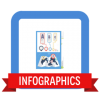
Infographics
What are Infographics?
Infographics are visual presentations of information that use the elements of design to display content. Infographics express complex messages to viewers in a way that enhances their comprehension. Images are often an extension of the content of a written article, but infographics convey a self-contained message or principle. If a road sign has too much information on it, then it is difficult to read. Infographics compress and display this information in a visually pleasing way so that drivers or viewers don’t miss the message. Infographics communicate complex data quickly and clearly, and they are considered to be effective worldwide.
How do you use Infographics in the classroom?
First, check out our 46 tools to create infographics. What you decide to do with those tools depends on if you want to make them, read them, or repackage them as other media forms. In a literature or language class for example, you might:
-
introduce the protagonist of a story
-
talk about a character’s decision in literature
-
highlight an important event or the climax in a story
-
compare a book with a movie
-
discuss the historical setting of a book
-
preteach a new subject
-
present a new idea or topic
Infographics can be intriguing for e-learners because they are able to combine pictures with information in a creative format using bright colors. They might be used as supplements to lesson plans or as starting points to get class discussions started.
Any discipline area can use infographics, if they have data or information to present to others.
Watch Kathy Shrock’s Presentation on Infographics as a creative assessment.
ISTE Standards Addressed:
1. Creativity and innovation
Students demonstrate creative thinking, construct knowledge, and develop innovative products and processes using technology.
a. Apply existing knowledge to generate new ideas, products, or processes
b. Create original works as a means of personal or group expression
d. Identify trends and forecast possibilities
2. Communication and collaboration
Students use digital media and environments to communicate and work collaboratively, including at a distance, to support individual learning and contribute to the learning of others.
b. Communicate information and ideas effectively to multiple audiences using a variety of media and formats
3. Research and information fluency
Students apply digital tools to gather, evaluate, and use information.
b. Locate, organize, analyze, evaluate, synthesize, and ethically use information from a variety of sources and media
d. Process data and report results
4. Critical thinking, problem solving, and decision making
Students use critical thinking skills to plan and conduct research, manage projects, solve problems, and make informed decisions using appropriate digital tools and resources.
c. Collect and analyze data to identify solutions and/or make informed decisions.
Places to Create Infographics:
Canva
Piktochart
Earn your Badge:
Create an infographic on Piktochart, Canva (or another site) and submit or have your students create one and submit.
